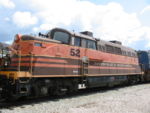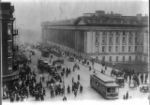Portal:US Railways/Selected article/2008 archive
This is an archive of article summaries that have appeared in the Selected article section of Portal:US Railways in 2008.
The EMD BL2 is a four-axle B-B road switcher built by General Motors Electro-Motive Division (EMD). Often considered the "Ugly Duckling" of diesel offerings from EMD, the BL2 set the stage for the company's widely successful GP series of locomotives. EMD's diesel program was well underway in the late 1940s and early 1950s, thanks to the success of the company's FT demonstrations across the country. While the F-units in production were great for moving trains over the railroad, their full-width carbody made it difficult for locomotive crews to see to the rear of the locomotive. The F-units also lacked anywhere for a brakeman or switchman to stand and ride short distances while performing switching duties. Another problem facing EMD was that ALCO was making inroads into a market that EMD would have liked to keep to themselves; ALCO's RS series switchers were starting to take over many of the tasks that EMD wanted to fulfill with their own locomotives. EMD's designers and engineers set to work and came up with the carbody reminiscent of the GG1 with mechanics that contained the technical knowledge they had learned with the company's F-unit series. This model of locomotive was sold for both freight and passenger service and the locomotive's intended purpose could be easily identified by the presence or absence of an exhaust stack between the two windshield panes. This exhaust stack was for the steam generator on passenger service units. EMD's engineers learned quite a bit from the endeavor and incorporated all of the good ideas from it into the company's widely successful GP series of locomotives.
For just under 100 years, between 1862 and 1962, Washington streetcars and interurbans transported people across the city of Washington, D.C. and the surrounding region. The first streetcars in D.C. were drawn by horses, but later cable cars were used. By the beginning of the 20th century, the streetcar system was fully electrified. A number of the District's streetcar lines were extended into Maryland, and a separate system was established for northern Virginia. Over the years, the various companies were party to numerous mergers and bankruptcies, until all of the streetcars were part of one company, Capitol Transit. Labor strife, the popularity of the automobile and pressure to replace the streetcars with buses led to their demise. In January 1962, the last car went on its last run. Elements of the system still remain as roads, bus barns, Metrobus depots, rail trails and unused abandoned infrastructure.
The Pioneer Zephyr is a diesel-powered railroad trainset (a set of railroad cars permanently coupled together, actually an articulated railcar with Jacobs Bogies) built by the Budd Company in 1934 for the Chicago, Burlington and Quincy Railroad (CB&Q), commonly known by the shorter name of Burlington. The train, which featured extensive use of stainless steel, was originally named Zephyr and was meant as a promotional tool to advertise passenger rail service in the United States. The train's construction included innovations such as shotwelding (a specialized type of spot welding) to join the stainless steel, and articulation to reduce the train's weight. On May 26 1934 it set a speed record for travel time between Denver, Colorado, and Chicago, Illinois, when it made a 1,015-mile (1,633 km) non-stop "dawn-to-dusk" dash, covering the distance in 13 hours 5 minutes at an average speed of 77 mph (124 km/h). For one section of the run, the train reached a speed of 112.5 mph (181 km/h), just short of the then-US land speed record of 115 mph (185 km/h). The historic dash inspired two films and the train's nickname, "Silver Streak". The trainset entered regular revenue service on November 11 1934 between Kansas City, Missouri, Omaha and Lincoln, Nebraska. It was operated on this route until its retirement in 1960 when it was donated to the Museum of Science and Industry in Chicago where it remains on public display. The train is generally regarded as the first successful streamliner on American railroads.
Portal:US Railways/Selected article/April 2008
Portal:US Railways/Selected article/May 2008
Portal:US Railways/Selected article/June 2008
Portal:US Railways/Selected article/July 2008
Portal:US Railways/Selected article/August 2008
Portal:US Railways/Selected article/September 2008
Portal:US Railways/Selected article/October 2008
Portal:US Railways/Selected article/November 2008



